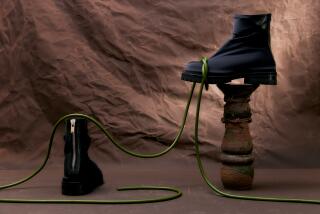Fine Fabrics Weave Tales of Times Past
- Share via
Fine home furnishing fabrics may fade, but their designs never age. They are rewoven and reprinted as new decorator wares.
They are also a rich source of social history, Richard Slavin says.
Slavin is the author of “Opulent Textiles: The Schumacher Collection,” (Crown Publishers, 1992, $50). The book uses some of the best textiles from F. Schumacher & Co. of New York to illustrate the passing parade of high styles in decorating from the turn of the century to the present.
Slavin is also curator of Schumacher’s collection of about 10,000 textile samples. The archive consists of antique fabrics as well as samples produced by the company since 1889.
Jane Nylander, director of the Society for the Preservation of New England Antiquities, wrote the book’s foreword. She says the value of old fabrics is recognized in a higher professional standard of care for many archives. Textile companies are more likely to hire professionals to sort out, identify, repair, photograph and catalog their fabric collections.
While companies such as Brunschwig & Fils, Lee Jofa Inc. and Scalamandre Inc. have mounted exhibits and published information about their fabrics, Nylander calls Slavin’s book “the most ambitious effort by an American textile firm to pen its holdings.”
“Opulent Textiles” offers a mini-history of American textile design and use during the century. Europe provided almost all of the fine silks and brocades until the late 19th century. Imports, particularly from France, are still prevalent. Schumacher found that they were more cost-efficient even though it owned and operated a mill in New Jersey from 1895 to 1989.
The rise of modernism created a need for fabrics for modern interiors, especially public spaces such as hotels, theaters and churches. Schumacher turned to artists and famous designers for new ideas--French couturier Paul Poiret, Austrian designer Joseph Urban and American architect Frank Lloyd Wright.
In the 1920s, when automobiles and yachts became status vehicles, Schumacher created custom textiles for cars, boats and private airplanes. A company advertisement in the 1920s proclaimed: “Your car, like your home, needs the smart personal touch that decorative fabrics give.”
Textiles make dandy historical documents. In 1939, Schumacher reproduced a toile fabric commemorating George Washington’s presidential inauguration. Fast-forward to 1956, when Mamie Eisenhower commissioned a toile fabric of the life and times of Ike. The Eisenhower toile decorated Blair House, guest quarters for foreign dignitaries visiting the nation’s capital. It also graced the Eisenhower farm at Gettysburg. The first lady even had a dress of the good Republican cloth, which was also sold as piece goods at retail.
One might imagine that fabrics improved with the times. Not so, Slavin says. Opulence came early.
“We imported silk brocades at the turn of the century that today would cost $1,500 to $2,000 a yard to duplicate because of the quality of the silk, the gold and silver threads and the hand workmanship,” he says. “The colors of the 1920s were more daring than today and some of the designs more sophisticated.”
Most of Schumacher’s luxury fabrics are based on antique originals. The main purpose of the archives is to develop new fabrics. Usually colors are updated to conform to fashion, and some may be eliminated (the more colors in a fabric, the higher the cost). Scale and number of motifs are also often changed because of loom and printing requirements.
“If our designers think it’s marketable,” Slavin says, “they may copy it exactly. But for us, that’s rare.”
More to Read
Sign up for our Book Club newsletter
Get the latest news, events and more from the Los Angeles Times Book Club, and help us get L.A. reading and talking.
You may occasionally receive promotional content from the Los Angeles Times.










